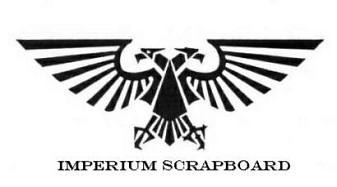

| Squats | 3 |
| Halflings | 3 |
| Most Eldar | 5 |
| Eldar Dark Reaper | 4 |
| Eldar Harlequin | 6 |
| Eldar Avatar | 6 |
| Most Swarms of Animals | 3 |
| Ogryn | 6 |
| Most Dreadnoughts and Fighting Robots | 6 |
| Enslaver | 6 |
| Astral Hound | 6 |
| Zoat | 7 |
| Crusader Fighting Robot | 8 |
| Horse | 8 |
| Genestealer | 6 |
| Genestealer Patriarch | 5 |
| Genestealer Hybrid | 4 |
| Most Tyranids | 6 |
| Hive Tyrant | 6 |
| Tyranid Termagants | 5 |
| Greater Demon (most) | 6 |
| Most Lesser Daemons | 4 |
| Chaos Hound | 6 |
| Flesh Hound of Khorne | 10 |
| Juggernaut of Khorne | 7 |
| Fiends of Slaanesh | 6 |
| Steed of Slaanesh | 12 |
| Great Unclean One | 4 |
| Nurglings | 4 |
| Beast of Nurgle | 3 |
| Tzeentch Lord of Change | 8 |
| Flamer of Tzeentch | 9 |
| Pink/ Blue Horror of Tzeentch | 4 |
| Disc of Tzeentch | 12 |
| Brush, Scrub and other vegetation |
| Open woodland or dense foliage |
| Debris, ruins, wreckage, loose rocks and boulders |
| Small crevasses and fissures |
| Stairs, ramps or steps. |
| Very thick forest and dense jungle |
| Steep or treacherous slopes |
| Fords, streams or shallow water |
| Soft sand or thick dust |
| Brush, scrub or clinging vegetation |
| Ladders and very steep ramps. |
| Marsh, bog and thick mud |
| Inside cluttered buildings and cramped vehicles. |
| Woods on treacherous slopes |
| Bog and dense foliage |
| Clinging vegetation and wreckage |
| Almost sheer slopes that need to be climbed on hands and knees |
| Tar pits and Swamps |
| Pools and fast following but still fordable rivers. |
| Level | Effect |
0 | Rain Stops. |
1 | Visibility only 12” |
2 | All movement half-rate. |
3 | All movement quarter rate. Wheeled and Walking vehicles bog down on 5+, tracks on 6. Rivers double width. Only medium and heavy vehicles can cross, and mediums get swept away on a roll of 6 at 6” downstream per turn. |
4 | No movement by any unit. Vehicles sink in mud and are permanently immobilized. Laser, Flamer, Melta and Plasma fire reduced to short range only. |
By the Author of the Scrapboard : | |
|---|---|
 | Attack, Avoid, Survive: Essential Principles of Self Defence Available in Handy A5 and US Trade Formats. |
 | |
 | Crash Combat Second Edition with additional content. Epub edition Second Edition with additional content. Crash Combat Third Edition Epub edition Third Edition. |
 | |
 | |